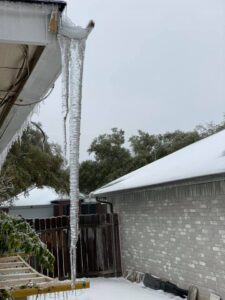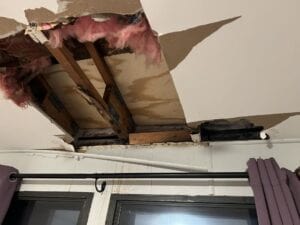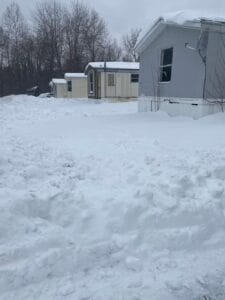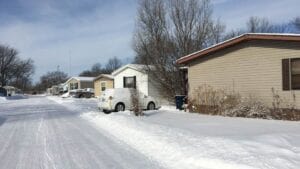Winter can be a wonderland, but it also brings its fair share of headaches. One such headache is the formation of ice dams on roofs. When snow melts and freezing temperatures hit, these icy barriers wreak havoc on gutters, shingles, and even ceilings. Ice dams are a common problem in colder climates during the winter months, causing significant damage to homes.
Preventing Ice Dams: Effective Tips
So how do these ice dams form? Well, as snowfall accumulates on your roof, heat from inside your home escapes through the attic, melting the bottom layer of snow. This melted snow then trickles down towards the eaves where it refreezes due to freezing temperatures. Over time, this process creates thick layers of ice that obstruct water runoff.

The consequences can be disastrous. As additional snow melts and cannot drain properly due to the dam, it seeps under shingles and into your home’s interior, causing water damage and costly repairs. To prevent this nightmare scenario, understanding the causes and effects of ice dams is crucial.
Don’t let these icy intruders ruin your winter wonderland! In this guide, we’ll delve deeper into what causes ice dams and explore effective prevention strategies to keep your home safe from their chilling grip. So grab a cup of cocoa and let’s get started!
Importance of Ice Dam Prevention
Preventing ice dams is crucial to avoid costly repairs and potential structural damage. By taking the necessary measures, you can extend the lifespan of your gutters and roof while preventing water leaks into your home. Regular maintenance and preventive actions significantly reduce the risk of future ice dams.
Addressing ice dam issues promptly is essential to prevent further complications. When snow accumulates on your roof, it can melt due to heat escaping from your home or warm weather conditions. As the melted snow flows down, it reaches the colder eaves of your roof where it refreezes, forming ice dams. These ice dams block proper drainage, causing water to back up under shingles and potentially leak into your home.
To prevent such problems, consider implementing the following preventive measures:
Insulate your attic: Proper insulation helps maintain a consistent temperature in your attic, reducing heat loss that contributes to snow melting on the roof.
Ventilate your attic: Adequate ventilation allows for proper airflow in the attic space, preventing warm air from accumulating and melting snow on the roof.
Seal air leaks: Identify and seal any gaps or cracks in your attic that may allow warm air to escape into the roofing system.
Clear snow from roofs: Safely remove excess snow from your roof using a roof rake or hiring professionals when necessary. This reduces the chances of excessive melting and subsequent ice dam formation.
Install gutter guards: Gutter guards act as a protective barrier against debris accumulation in gutters, ensuring proper water flow during winter months.
Keep gutters clean: Regularly clean out leaves, twigs, and other debris from gutters to maintain unobstructed water flow away from the roofline.
Use heat cables: Installing heat cables along the eaves can help melt snow before it turns into ice dams by providing a source of heat.
By implementing these preventive measures, you can significantly reduce the risk of ice dams forming on your roof. Not only will this prevent potential structural damage and costly repairs, but it will also ensure that water stays out of your home, protecting your belongings and maintaining a safe living environment.

Remember, taking proactive steps to prevent ice dams is far more effective and cost-efficient than dealing with the consequences afterward. So prioritize ice dam prevention to safeguard your gutters, roof, and overall property from the damaging effects of winter weather.
Read more on our article: Mobile Home Gutters
Effective Methods for Preventing Ice Dams
Proper insulation in attics is crucial. By ensuring that your attic is well-insulated, you can maintain a consistent roof temperature and minimize the risk of snow melting and refreezing into ice dams. Adequate insulation acts as a barrier, preventing warm air from escaping through the roof and causing snowmelt.
In addition to insulation, proper ventilation plays a significant role in ice dam prevention. When warm air accumulates in the attic, it can lead to snowmelt on the roof, which then refreezes and forms ice dams. By having adequate ventilation systems in place, you allow the warm air to escape rather than being trapped in the attic space. This helps keep the temperature of the roof consistent and reduces the likelihood of ice dam formation.
Sealing any air leaks around chimneys, vents, and skylights is another effective method for preventing ice dams. These areas are often prone to heat loss due to poor sealing or inadequate insulation around them. By addressing these leaks and ensuring proper sealing, you can minimize heat loss from your home and reduce the chances of snowmelt leading to ice dam formation.
Removing excess snow from roofs is an essential step in preventing ice dams. The weight of accumulated snow can contribute to increased pressure on your roof, making it more susceptible to damage and potential water leakage. Excess snow provides more material for ice dams to form as it refreezes. Regularly removing excess snow from your roof not only reduces this risk but also helps maintain its structural integrity.
Here are some additional tips for preventing ice dams:
Use a roof rake or hire professionals to safely remove accumulated snow from your roof.
Install heating cables along the edges of your roof to prevent refreezing.
Clear gutters regularly to ensure proper drainage.
Inspect your attic for any signs of moisture or water damage, as these can indicate potential ice dam issues.
By implementing these preventive measures, you can significantly reduce the likelihood of ice dams forming on your roof. Remember, proactive maintenance and regular inspections are key to keeping your home safe from the damaging effects of ice dams. Stay vigilant and take necessary steps to protect your property during winter months.

Safe and Efficient Ice Melt Options for Gutters
Using the right ice melt product is crucial. Calcium chloride or magnesium chloride-based ice melts are safe options that effectively melt ice without causing damage to your gutters. On the other hand, rock salt or sodium chloride can be harmful as they may corrode gutter materials over time.
To ensure the safety and longevity of your gutters, follow these tips when selecting and applying ice melt products:
Use Calcium Chloride or Magnesium Chloride-Based Ice Melts
Calcium chloride and magnesium chloride-based ice melts are excellent choices for melting ice in gutters. These products have a lower risk of causing damage compared to rock salt or sodium chloride. They work by lowering the freezing point of water, allowing it to melt even at colder temperatures.
Avoid Rock Salt or Sodium Chloride
Rock salt or sodium chloride may be readily available and inexpensive, but they can be detrimental to your gutter system. The high salt content in these products can lead to corrosion, weakening the integrity of your gutters over time. It’s best to steer clear of them when selecting an ice melt option.
Apply Ice Melt Products in Moderation
While calcium chloride and magnesium chloride-based ice melts are safe for gutters, it’s essential not to go overboard with their application. Using excessive amounts can potentially harm plants and vegetation below the gutters due to runoff. To prevent any damage, apply the ice melt product sparingly according to the manufacturer’s instructions.
Regularly Clear Debris from Gutters
To ensure proper drainage during melting periods, it is crucial to regularly clear debris from your gutters. Leaves, twigs, and other debris can accumulate over time and obstruct water flow. By keeping your gutters clean, you allow melted snow and ice to flow freely through the system without creating additional problems.
In addition to using ice melt products, consider implementing preventive measures such as installing gutter helmets. Gutter helmets act as protective covers that prevent debris from entering the gutters while allowing water to flow freely. This reduces the likelihood of ice dams forming in the first place.
Installing Roof Heated Cables for Ice Dam Prevention
Roof heated cables, also known as heat cables or regulating cables, are a valuable solution for preventing ice dams and maintaining the integrity of your gutters. These specialized cables help create a clear path for melted snow to drain off the roof safely, mitigating the risk of damage caused by ice dams.
One of the key areas where ice dams commonly form is along the eaves and valleys of roofs. This is where heated cables come into play. By installing these cables in these vulnerable areas, you can effectively prevent snow accumulation that leads to ice dams.
The heating elements within these cables work diligently to regulate temperatures on your roof’s surface. As snow begins to melt, the heated cables generate warmth that prevents it from refreezing and forming ice dams. This constant wattage ensures that water flows freely off your roof instead of getting trapped and causing potential damage.
While some homeowners may consider installing heated cables themselves, professional installation is highly recommended. Optimal placement and effectiveness of the heated cables require expertise and knowledge in understanding your unique roofing system’s needs. Professionals will ensure that the heated cables are installed correctly along the eaves and valleys, maximizing their efficiency in preventing ice dams.
To further enhance your efforts in preventing ice dams, it’s crucial to address other contributing factors such as attic insulation and ventilation. Proper attic insulation helps maintain a consistent temperature throughout your home while minimizing heat loss through the roof. Adequate attic ventilation allows hot air to escape from your attic space, reducing the chances of snow melting prematurely on your roof.
When installing roof heated cables, it’s essential to follow a few steps to ensure their effectiveness:
Begin by cleaning out any debris or leaves from your gutters and downspouts.
Install an underlayment along the eaves before attaching the heated cable.
Securely fasten the cable using appropriate equipment according to manufacturer instructions.
For optimal results, consider installing a helmet heat system that covers the heated cables, further protecting them from external elements.
It’s worth noting that while roof heated cables are an effective solution, they are not a standalone fix for ice dams. They work in conjunction with proper attic insulation and ventilation to create an overall comprehensive prevention strategy.

Hiring Professional Roofers for Ice Dam Solutions
Hiring professional roofers is the best option. These experienced experts have the necessary skills and knowledge to accurately assess your specific ice dam issues and provide tailored solutions. Let’s explore why hiring professionals is essential.
Accurate Assessment of Your Specific Ice Dam Issues
Ice dams can cause significant damage to your roofing system if not addressed promptly and effectively. Professional roofers have the expertise to identify the root causes of ice dams on your roof. They can assess factors such as inadequate insulation, improper ventilation, or faulty shingles that contribute to the formation of ice dams.
By conducting a thorough examination, professionals can determine the severity of your ice dam problem and provide appropriate recommendations. Their accurate assessment ensures that you receive targeted solutions rather than relying on generic approaches found at a hardware store.
Tailored Solutions for Preventing Ice Dams
Prevention is key. Professional roofers are well-versed in implementing preventative measures specific to your home’s needs. They can suggest various options, including:
Improving insulation in your attic to regulate temperature and prevent heat loss.
Enhancing ventilation systems in your eaves to maintain consistent airflow.
Installing specialized roofing products designed to combat ice dam formation.
Conducting regular maintenance and inspections to identify potential issues before they escalate.
These tailored solutions address the underlying causes of ice dams, mitigating their occurrence in the long run.
Necessary Equipment and Expertise for Safe Removal
Removing existing ice dams requires caution and expertise. Professionals possess the necessary equipment like roof rakes that allow them to safely remove accumulated snow from roofs without causing damage. Unlike do-it-yourself (DIY) attempts using household tools, professional roofers understand how much pressure should be applied during the removal process without harming your roof.
Professionals are trained to work at heights and take necessary safety precautions. They have the experience to navigate slippery surfaces while protecting themselves and your property.
Regular Maintenance and Inspections for Future Prevention
Preventing ice dams is an ongoing commitment. Professional roofers can provide regular maintenance and inspections to ensure that your roofing system remains in optimal condition. By scheduling routine check-ups, they can identify potential issues early on and address them promptly, preventing ice dams from forming in the future.
Homeowners who rely on DIY methods may overlook critical signs of damage or fail to implement preventative measures effectively. Hiring professionals guarantees that your roof receives the attention it deserves, minimizing the risk of recurring ice dam problems.
Removing Ice Dams from Gutters: Techniques and Solutions
Quick action is key to prevent costly damage to your roof and home. Ice dams occur when snow on the roof melts and refreezes near the edges, forming thick bands of ice that block proper drainage through the gutter system. To safeguard your property, it’s crucial to understand effective techniques for removing ice dams from gutters.
Using a roof rake: One of the simplest ways to combat ice dams is by using a snow rake to carefully remove excess snow from the roof. By keeping the roof surface clear, you minimize the chances of melting snow contributing to ice dam formation. Start at the edge of the roof and work your way up, gently pulling down accumulated snow without damaging shingles or gutters.
Gently breaking up existing ice dams: If an ice dam has already formed, it’s important to address it promptly. Use a blunt instrument like a rubber mallet or wooden dowel to gently break apart sections of the dam. Avoid using sharp objects that could damage your roofing materials. Another option is applying warm water with caution along the affected area, aiding in melting away the ice dam gradually.
Installing gutter guards: Preventing debris accumulation in gutters can significantly reduce the likelihood of ice dams forming in the first place. Gutter guards act as barriers that allow water to flow freely while preventing leaves, twigs, and other debris from clogging gutters. By maintaining clean and unobstructed gutters, you can mitigate one of the main factors contributing to ice dam formation.
Consulting with professionals: While DIY methods can be effective for smaller ice dams, larger or more persistent ones may require professional assistance for safe removal methods. Ice dam removal pros have specialized equipment like steamers that use hot water or steaming techniques to safely melt away the ice. Their expertise ensures the removal process is conducted without causing damage to your roof or gutters.
Removing Ice Dams From Gutters
Removing ice dams from gutters can be a time-consuming process that may take several days, depending on the severity of the situation. It’s important to exercise caution and prioritize safety throughout the removal process. If you’re unsure about tackling ice dam removal on your own, it’s always wise to seek professional guidance.
Conclusion: Preventing Ice Dams
In conclusion, preventing ice dams in your gutters is crucial to protect your home from potential damage. By taking proactive measures and implementing effective prevention methods, you can avoid the costly repairs and inconveniences associated with ice dams.
One of the most important takeaways is understanding the significance of ice dam prevention. By keeping your gutters clear of ice dams, you can prevent water from seeping into your roof and causing leaks, structural damage, or mold growth. This not only safeguards the integrity of your home but also helps maintain its value over time.
To effectively prevent ice dams, there are several methods you can employ. Regularly clearing snow from your roof using a roof rake or shovel can help minimize the accumulation that leads to ice dams. Insulating your attic and ensuring proper ventilation will help regulate temperatures and prevent melting snow from refreezing at the eaves.
Consider using calcium chloride or other specialized ice melt products designed for this purpose. These products can effectively melt away existing ice dams without causing harm to your gutters or downspouts.
Another effective solution is installing roof heated cables along the eaves of your roof. These cables generate heat that prevents snow from melting and refreezing as it reaches the edge of your roof. This method provides continuous protection against ice dams throughout winter.
While some DIY approaches may work well for preventing and removing minor ice dams, it’s often advisable to hire professional roofers for more complex situations. Experienced professionals have the expertise and equipment necessary to assess your specific needs and provide tailored solutions that ensure long-term prevention.
Final Tips: Preventing Ice Dams
In summary, addressing ice dam issues promptly is essential for maintaining a safe and secure home environment during winter months. By implementing preventive measures such as regular maintenance, insulation, and utilizing safe de-icing options like heated cables or specialized products, you can significantly reduce the risk of ice dams and their associated problems.
Remember, prevention is key. By taking proactive steps to mitigate the risk, you can protect your home and save yourself from potential headaches down the line.
FAQs: Preventing Ice Dams
Q: How do ice dams form in gutters?
Ice dams form when heat escapes from the attic and warms the roof, causing snow on top to melt. As this melted snow reaches the eaves, which are colder due to overhangs or lack of insulation, it refreezes and forms a dam-like barrier.
Q: Can I prevent ice dams by using salt or rock salt?
Using salt or rock salt may seem like a quick solution, but it can be damaging to your gutters and downspouts. These substances can cause corrosion and harm nearby vegetation. It’s best to use specialized ice melt products that are safe for gutters and designed specifically for this purpose.
Q: Are heated cables a permanent solution for preventing ice dams?
Heated cables provide an effective solution for preventing ice dams; however, they require proper installation and maintenance. While they offer continuous protection during winter months, regular inspection is necessary to ensure optimal performance.
Q: How often should I clear my gutters during winter?
Regularly clearing your gutters during winter is crucial for preventing ice dams. Depending on weather conditions in your area, aim to clear any accumulated snow or debris at least once every two weeks or as needed to maintain proper drainage.
Q: Should I attempt to remove ice dams myself?
While minor ice dams can sometimes be safely removed with DIY methods such as using a roof rake or warm water-filled socks placed on the dam, it’s recommended that you hire professionals for more significant or complex cases. They have the expertise and equipment required to remove ice dams without causing further damage.
Remember that prevention is key when dealing with ice dams in your gutters. By taking proactive measures, utilizing effective prevention methods, and seeking professional assistance when needed, you can protect your home from the damaging effects of ice dams. Stay safe and enjoy a worry-free winter season!
You might also be interested in our articles:

